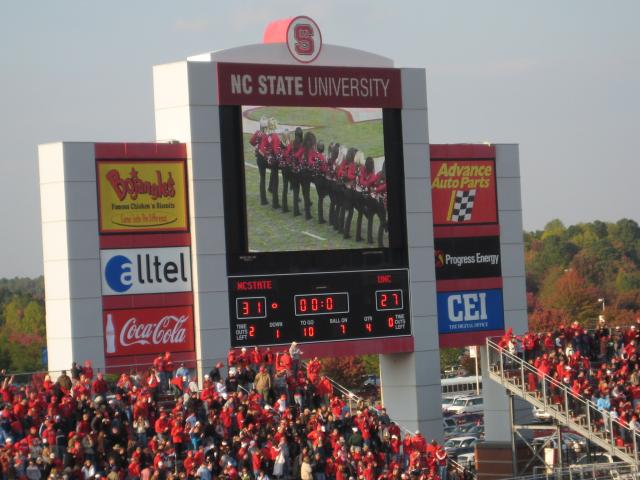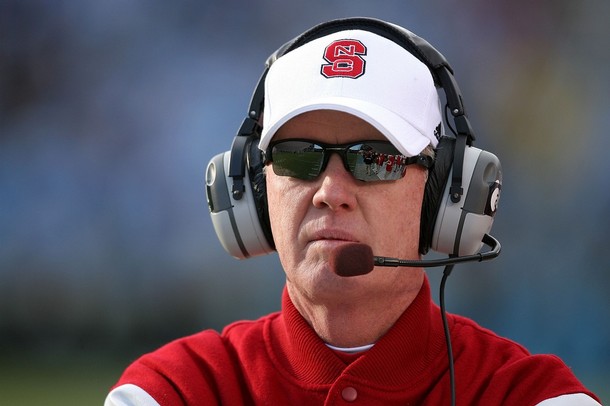
A nerve-racking goal-line stand preserved the 31-27 victory on November 10, 2007
Part I: The 90s
Part II: Chuck
Part III: 17
Part IV: TOB
 Chuck Amato deserves much of the credit for the current state of Carter-Finley, the renewed pride and excitement for football, and for fueling our aspirations of national prominence. The latter actually proved to be his eventual downfall: by raising our expectations he built a monster that he couldn’t control. Once it was clear he was vastly incapable of delivering on his far-reaching rhetoric, he began a systematic alienation of his fan base and, apparently, the Big Money. He’d always been a talker, but by 2006 he was no longer able to talk his way into extending his welcome.
Chuck Amato deserves much of the credit for the current state of Carter-Finley, the renewed pride and excitement for football, and for fueling our aspirations of national prominence. The latter actually proved to be his eventual downfall: by raising our expectations he built a monster that he couldn’t control. Once it was clear he was vastly incapable of delivering on his far-reaching rhetoric, he began a systematic alienation of his fan base and, apparently, the Big Money. He’d always been a talker, but by 2006 he was no longer able to talk his way into extending his welcome.
It was painfully evident that what we needed after the 2006 season was a steady presence, a proven success, to redirect the sputtering program.
Uncommon for Lee Fowler, Tom O’Brien’s hiring was quick, smooth and definitive. He arrived at State with little fanfare (largely due to the simultaneous hiring of Nick Saban by Alabama), although his hiring did generate an appropriately quiet buzz nationally – most pundits agreed that he was an excellent hire for a program that needed, above all, stability. He proved a refreshing presence with his steady, focused approach to both coaching and relating to the monster that is the N.C. State fan base (especially LRM). He showed an immediate panache for fitting in, which around these parts is sometimes as simple as doing a Bojangle’s commercial.
The irony with O’Brien is that in 2009, he seems, if not the perfect fit, at least a most excellent fit; but back in 2000 that wouldn’t have been the case. Without the initial surge under Amato and then the subsequent freefall after Philip left, most of us would hardly appreciate the fact that O’Brien was a steal. Back in 2000, we needed a coach with Amato’s outward passion – O’Brien simply lacks that inherent swagger, tending instead towards silent bravado – but in 2009, O’Brien seems (at least so far) to be exactly the leader we need to build a solid foundation and then focus on long-term prominence, which is something that has escaped the State fan for generations.
A legacy of George Welsh (regarded by most as the model of winning consistency in college football), O’Brien came to State after establishing his own staple consistency. In 1996, he took over a Boston College program that was mired in scandal and within two years shaped it into a perennial eight-game winner, winning nine games during four of his final five seasons in Chestnut Hill. For perspective: State has only four nine-win seasons over the past twenty years, two of which were under Dick Sheridan in 1991 & 1992 (the others were 1994, under O’Cain; and 2002, under Amato). He spent 10 years at Boston College and led the Eagles to eight consecutive bowl games, winning each of the final six.
O’Brien proved successful at Boston College despite a morosely apathetic fan base and facilities far inferior to those in Raleigh even before the current renovations. He’d coached in Raleigh as an assistant at Virginia, but his only trip to Carter-Finley as head coach of Boston College was in October 2006 – an aside: if Daniel Evans hadn’t thrown that Hail Mary that night, we would have all been spared a lot of heartburn from three years of the Anti-Philip — but even in that losing effort, he was left impressed with State fans’ enthusiasm. He announced during his initial press conference after being hired that he had decided that night if he ever left Boston College, it was “N.C. State or bust.â€
Now, I’m certainly not an O’Brien biographer, but by all indications, his reputation for consistency is borne of pragmatism. Not dissimilar to when he went to Boston College, he came to State with the implicit understanding that the short-term would be difficult. Beyond the obvious issues in 2006 – poor discipline, which had led to excessive, unnecessary penalties; poor execution, which had led to excessive turnovers; and poor attitudes, which had resulted in erratic, uninspiring play – he inherited a mess of a program. Beyond the staggering lack of fundamentals needed for success, injuries and depth issues were epidemic. Moreover, he would have to rebuild a paper-thin offensive line while simultaneously developing a new offensive system, all without even a remotely serviceable quarterback.
He lost his coaching debut to Central Florida 25-23 (at home), and his comments after the game indicated a certain delight in the fact his team had lost: it would reinforce his point that this group would buy into his system and his philosophy; otherwise they’d suffer the indignity of losing. It took a 1-5 start for the message to apparently get across, but over the final six games, State was 4-2, largely because the offense reduced its turnovers by half and Nate Irving emerged as an overwhelming presence on defense. After an uninspired performance in a season-ending home loss to Maryland, O’Brien’s first team finished 5-7. The theme that first season wasn’t much different than the previous two decades: we lost a game we shouldn’t have lost (Central Florida) and won a game we shouldn’t have won (at Miami); however, the glaring exception was the gut-wrenching November 10 goal-line stand in the final seconds to secure the 31-27 victory over Carolina in Raleigh.
The realists among us tempered our expectations for 2008. The options at quarterback were Daniel “Pick Six†Evans and Harrison “Just Heave It†Beck, and then some relative-unknown named Russell Wilson. Going into the season opener in Columbia, O’Brien named Wilson the starter; the announcement seemed to draw neither praise nor condemnation, simply because in the five seasons Anno Philip, we’d been conditioned to expect very little from the position. After two decades of, at the very least, serviceable quarterbacks, Davis, Stone, Evans, Beck and Burke had all been washouts. The problems were decision-making and accuracy: this quintet combined for a total of only 54 touchdowns with 82 interceptions from 2004-2008. The single-worst combined performance was in the loss at home against Clemson in 2007 (also known as the day Carter-Finley ran out of water), when Evans, Beck and Burke each somehow managed to throw an interception (I’ll stand firm that this has to be a record among BCS teams).
So I’ll admit, last August I wasn’t exactly high on Wilson, but he was a better option than Evans or Beck, which wasn’t really saying much.
And in that ESPN Thursday Night opener against the Gamecocks, he was hardly impressive. Before he was knocked out of the game with a concussion, he was a mere one-of-five for 12 yards passing. More damning for O’Brien was the second consecutive shutout – and blowout – loss: the 2007 season had ended with a 37-0 loss to Maryland in Raleigh and then the 2008 season began with a 34-0 loss at South Carolina. The following week, State defeated William & Mary in a game closer than it should’ve been. Then the next week at Death Valley, we failed to score an offensive touchdown for the third consecutive game against a Division I-A opponent in a 27-9 loss to Clemson; Wilson was again unimpressive, with an interception and only 10-of-21 passing. The realistic and reasonable – nay, rational – among us were delaying our hopes for any sustained success until O’Brien could get some experience on the line to protect the Glennon kid in a couple years. But as September grinded past, some of us weren’t sure we were ready to give O’Brien the time we all knew he realistically needed.
When East Carolina came to Raleigh on September 20, State completed one part of the recurring theme with a fourth-quarter rally for a 30-24 overtime win – we won a game we shouldn’t have won. Wilson’s legacy began with a three-touchdown performance on 21-of-31 passing for 210 yards, and his freshman campaign ended after he threw 17 consecutive touchdowns without an interception the rest of the season. By the Thanksgiving weekend regular season finale against Miami, we were firmly entrenched in a love affair of Wilson’s arm, mobility and decision-making, which spurred his improbable run to both the ACC Rookie of the Year and First Team All ACC.
On Wilson’s back, State rattled off four consecutive wins against Duke, Wake, Carolina, and then Miami to salvage a 6-6 record and slip into the Papajohns.com Bowl in Birmingham as the ACC’s tenth bowl team. Even though State collapsed – sans Wilson – in the second half of that game, leaving O’Brien with a losing record of 6-7 on the season, he finally broke the trend of the past two decades by not losing any games we shouldn’t have lost and winning a game – or in this case, two – we probably shouldn’t have won (at Carolina, Wake). Now, it’s no doubt arguable we lost games we had a chance to win (Boston College, Florida State, Maryland, Rutgers), but none of these were games we went into as the favorite. But most importantly, O’Brien moved to 2-0 against Butch Davis and Carolina after a 41-10 rout in Chapel Hill on November 22, which turned out to be just another game for us.
If the two stick around, O’Brien will forever be compared to his rival, Butch Davis. It’s an argument I’m neither prepared to make nor defend this early in their tenures, but early returns suggest that while Davis will probably always out-recruit O’Brien, and probably win some games against State simply because of the talent-level, O’Brien will usually out-coach Davis, and win some games against Carolina he shouldn’t, just like in 2008.
Now, I’m not quite ready to anoint O’Brien as The One (let’s start with a winning season first), but as long as he keeps beating Carolina, I’ll certainly leave that option open.



You must be logged in to post a comment.